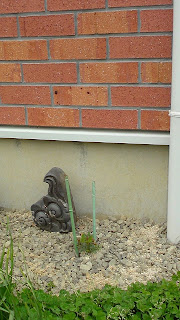The psychology of collecting, ordering and naming specimens could be seen as a form of mental colonising and empire-building. 'Taxonomy, after all, is a form of imperialism. During the nineteenth century, when British naval surveys were flooding London with specimens to be classified, inserting them in their proper niches in the Linnaean hierarchy, had undeniable political overtones. Take a bird or a lizard or a flower from Patagonia or the South Seas, perhaps one that had a local name for centuries, rechristen it with a Latin binomial, and presto! It had become a tiny British colony'. Anne Fadiman, 'Collecting Nature', in At Large and at Small.My yellow and white Rosa banksiae are presently very small. Indeed the white one is almost invisibly small (did I actually pay for these two leaves and bit of stalk?).
A record of my efforts to build a sustainable house and garden in Matsuyama, Japan
Saturday, March 28, 2009
Botanical imperialism
My recent experiences with "Lady Banks' Rose" and "the Duke of Argyll's tea tree" got me thinking about the horrid parochiality of these names. I'm not especially keen on political correctness, but as a republican, I don't like to recognize the Nobs, especially when they're linked almost inextricably to the names of Asian plants. Until very recently, I didn't have a clear idea who "Lady Banks" was, but I felt it strange that a Chinese rose that I know of as 'mokkobara' (scented tree rose) should go by the Latin name of an 18th Century Englishwoman. Since the rose and the berry in my acquaintance have long Asian histories, it seems wrong that they should have British names, especially when these are codified as taxonomic names. Rather coincidentally I became aquainted with the Banks' in a book my parents sent me, The Age of Wonder by Richard Holmes. As someone who danced naked with Tahitians, Mrs Bank's husband Joseph was a thoroughly cosmopolitan man, and so one doesn't want to be too hard. But the Latin name of the mokkobara still rankles. I was very surprised though to find a footnote in The Age of Wonder that almost perfectly expressed my feelings on the matter.
Subscribe to:
Post Comments (Atom)



No comments:
Post a Comment